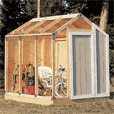Storage Shed Plans
For The Do-It-Yourselfer
Why would you need storage shed plans? Building your own storage shed is an economical way to solve your storage solutions. Sometimes it's just better to start with a plan.



Free storage shed plans are available online. Check in at Shedplans.org or construct101.com for all the details. Now consider whether this is something you really want to tackle, considering all the other options like the ones shown here. You will need to think about the lumber you want to use. Here are a few tips.
- Pressure-Treated Lumber: This type of lumber is resistant to rot, decay, and insect damage, making it ideal for the structural components of your shed, such as the foundation, floor joists, and framing.
- Plywood or Oriented Strand Board (OSB): These materials work well for sheathing the walls and roof of your shed. Opt for exterior-grade plywood or OSB to ensure durability and weather resistance.
- Cedar or Redwood (Optional): If you prefer a more aesthetically pleasing look, consider using cedar or redwood for the siding or trim. These types of wood are naturally resistant to decay and insects.
Your building skill need to be considered also, these tips might help.
- Carpentry Skills: Basic carpentry skills will be valuable for framing the structure, assembling the walls, roof, and doors, as well as installing windows (if applicable). Familiarity with measuring, cutting, and joining lumber will be essential.
- Foundation and Leveling: Understanding how to prepare the site, level the ground, and create a solid foundation is crucial to ensure stability and longevity of your shed.
- Roofing Skills: If you plan to build a sloped roof, knowledge of roofing techniques, including laying down underlayment, shingles, or other roofing materials, will be necessary.
As for those storage shed plans, do you need them? Having a set of plans or a detailed blueprint is highly advisable, especially if you're new to construction projects. Plans can provide guidance on dimensions, materials, and assembly steps, ensuring your shed is structurally sound and meets your needs. You can find pre-made shed plans online or consider designing your own using software like SketchUp or AutoCAD.
There are both free and paid shed plans available, and the quality can vary. Whether you should pay for plans or use free ones depends on your specific requirements and preferences. Here are some factors to consider:
- Complexity and Customization: Free plans may offer basic designs that suit common needs, but if you have specific requirements or want a more complex design, paid plans might be a better option. Paid plans often provide more detailed instructions, multiple design options, and customization features to match your preferences.
- Professional Guidance: Paid plans are typically created by experienced designers or architects who ensure the plans meet structural requirements and local building codes. If you're new to construction or have limited experience, investing in plans from reputable sources can provide added assurance and guidance.
- Support and Extras: Paid plans often come with additional resources such as video tutorials, material lists, and customer support. If you value these extras and want a more comprehensive package, paying for plans might be worthwhile.
- Budget: If you're on a tight budget, free plans can be a good starting point. They can offer a general understanding of shed construction and serve as a foundation for customization. However, keep in mind that you might need to invest extra time in researching and validating the accuracy and safety of free plans.
Ultimately, the decision to pay for plans or use free ones depends on your level of experience, the complexity of your desired design, and your budget. It's important to carefully evaluate the quality, reliability, and compatibility of any plans you choose to ensure a successful and safe construction process.
Building a Patio Cover | Travel Trailer Awnings | Awning Structures
Storage Sheds | Storage Shed Kits
Instant Garage | Mobile Home Decks | Patio Cover Plans
Patio Cover Construction | Vinyl Patio Covers | Patio Cover Kits
Patio Shade | Motorized Awnings | Sunsetter Retractable Awnings
Greenhouse Kits | Discount Storage Shed


